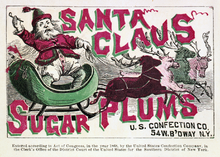 Christmas Eve evokes many pleasant memories in our minds and one of them is sugar plums. Tchaikovsky had a sugar plum fairy in The Nutcracker and Clement C Moore had visions of sugar plums dancing in the heads of sleeping children in his poem A Visit From St. Nicholas (aka “Twas the Night Before Christmas”). As familiar as the sugar plum is to Christmas, what do you really know about it?
Christmas Eve evokes many pleasant memories in our minds and one of them is sugar plums. Tchaikovsky had a sugar plum fairy in The Nutcracker and Clement C Moore had visions of sugar plums dancing in the heads of sleeping children in his poem A Visit From St. Nicholas (aka “Twas the Night Before Christmas”). As familiar as the sugar plum is to Christmas, what do you really know about it?
Here are some interesting facts about sugar plums:
 Traditional sugar plums made in the 1600s were a seed or nut enclosed in a sugary shell. Almonds, caraway seed and cardamom seeds were most commonly used as the core.
Traditional sugar plums made in the 1600s were a seed or nut enclosed in a sugary shell. Almonds, caraway seed and cardamom seeds were most commonly used as the core.
 The name probably came from the oval shape that resembled a plum.
The name probably came from the oval shape that resembled a plum.
 The process of making the sugary shell, called panning, was laborious and took several days. The shell is similar the one found on a jellybean or M & M’s.
The process of making the sugary shell, called panning, was laborious and took several days. The shell is similar the one found on a jellybean or M & M’s.
 Sugar plums were considered a luxury and became associated with a lot of money, something especially desirable, and a bribe.
Sugar plums were considered a luxury and became associated with a lot of money, something especially desirable, and a bribe.
 Mechanization of the panning process in the mid 1800’s changed the nature of making sugar plums and made them less of a luxury and more available to the common people.
Mechanization of the panning process in the mid 1800’s changed the nature of making sugar plums and made them less of a luxury and more available to the common people.
 The name sugar plum began to be applied to all sorts of different oval shaped candies that were available at this time. This included candies made from dried plums, figs, apricots, dates, and cherries. Honey and aromatic spices such as fennel, and anise might also be included.
The name sugar plum began to be applied to all sorts of different oval shaped candies that were available at this time. This included candies made from dried plums, figs, apricots, dates, and cherries. Honey and aromatic spices such as fennel, and anise might also be included.
 Moore wrote his poem in 1832, before the mechanization of panning process, so his sugar plums are probably the traditional ones. Tchaikovsky’s Sugar Plum Fairy, however, could have been either the traditional sugar plum or any oval candy.
Moore wrote his poem in 1832, before the mechanization of panning process, so his sugar plums are probably the traditional ones. Tchaikovsky’s Sugar Plum Fairy, however, could have been either the traditional sugar plum or any oval candy.
Wikipedia image